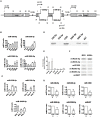Regulation of miRNA 219 and miRNA Clusters 338 and 17-92 in Oligodendrocytes
- PMID: 22470405
- PMCID: PMC3314186
- DOI: 10.3389/fgene.2012.00046
Regulation of miRNA 219 and miRNA Clusters 338 and 17-92 in Oligodendrocytes
Abstract
MicroRNAs (miRs) regulate diverse molecular and cellular processes including oligodendrocyte (OL) precursor cell (OPC) proliferation and differentiation in rodents. However, the role of miRs in human OPCs is poorly understood. To identify miRs that may regulate these processes in humans, we isolated OL lineage cells from human white matter and analyzed their miR profile. Using endpoint RT-PCR assays and quantitative real-time PCR, we demonstrate that miR-219, miR-338, and miR-17-92 are enriched in human white matter and expressed in acutely isolated human OLs. In addition, we report the expression of closely related miRs (miR-219-1-3p, miR-219-2-3p, miR-1250, miR-657, miR-3065-5p, miR-3065-3p) in both rodent and human OLs. Our findings demonstrate that miRs implicated in rodent OPC proliferation and differentiation are regulated in human OLs and may regulate myelination program in humans. Thus, these miRs should be recognized as potential therapeutic targets in demyelinating disorders.
Keywords: differentiation; microRNA; myelination; oligodendrocyte precursor cell.
Figures




References
-
- Barad O., Meiri E., Avniel A., Aharonov R., Barzilai A., Bentwich I., Einav U., Gilad S., Hurban P., Karov Y., Lobenhofer E. K., Sharon E., Shiboleth Y. M., Shtutman M., Bentwich Z., Einat P. (2004). MicroRNA expression detected by oligonucleotide microarrays: system establishment and expression profiling in human tissues. Genome Res. 14, 2486–249410.1101/gr.2845604 - DOI - PMC - PubMed
-
- Chen C., Ridzon D. A., Broomer A. J., Zhou Z., Lee D. H., Nguyen J. T., Barbisin M., Xu N. L., Mahuvakar V. R., Andersen M. R., Lao K. Q., Livak K. J., Guegler K. J. (2005). Real-time quantification of microRNAs by stem-loop RT-PCR. Nucleic Acids Res. 33, e179.10.1093/nar/gni178 - DOI - PMC - PubMed
LinkOut - more resources
Full Text Sources
Other Literature Sources

